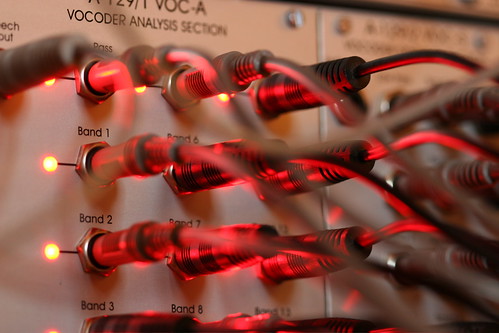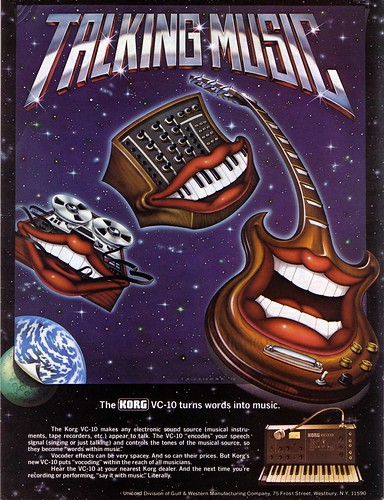Sure, the vocoder may now be something of an electronic music cliché now, but it got its beginnings as a mechanism of encoding speech. It was one of the first electronic instruments. It helped inspire the conceptual model for all digital communication. And, those lofty goals aside, it can still sound terrific when used creatively. (Hint: you don’t have to use your voice as a source.)
These are heady times for the vocoder. Hosts are getting better at accomplishing the routings necessary to produce vocoding effects. Software and hardware vocoders are appearing everywhere. And of course, the great moment has been Ableton releasing a Vocoder in its upcoming Live 8, not so much because of Live or that Vocoder, but because company co-founder Robert Henke was immortalized in a remix (video above) talking about how you wouldn’t need it. I expect one of the first unofficial Live 8 tutorials may use this clip. (Apologies to Robert – especially as that’s exactly the sort of thing I might say speaking to students, and I actually agree. You don’t need a vocoder. For one thing, if you know what you’re doing, you can patch your own. But I digress.)
History and Vocoding without Autopilot
For a different take on the vocoder, let’s first take a trip back in time.
The device in the video is the 1939 “Voder” (Voice Operating Demonstrator). To me, this really demonstrates how much potential is left in the process. The original Voder was played more as an instrument.
Via the always wonderful Digital Tools.
Wendy Carlos, whose use of the vocoder in Clockwork Orange may be as significant to the vocoder as Carlos’ “Switched on Bach” was to the Moog, explains how the Voder functioned:
Homer Dudley also invented the VODER (Voice Operating DEmonstratoR), an electronic speaking instrument, which was unveiled (and demonstrated hourly) at the New York World’s Fair 1939-40. Inside the tall rack of sturdy electronic gear was a pitch controlled reedy oscillator, a white-noise source, and ten bandpass resonant filters. For a Voder to “speak” a talented, diligently trained operator “performed” at a special console connected to the rack, using touch-sensitive keys and a foot-pedal. These controlled the electronic generating components. The results, while far from perfect (it was damn difficult to operate!), were still entertaining and instructive of the principles involved.
That whole article is a must-read, whether you’re a fan of Kubrick, Carlos, vocoders, or (most likely) all three:
“Vocoder Questions” by Kurt B. Reighley, Editor, CMJ New Music Monthly (interviewing Wendy Carlos) [wendycarlos.com]
People who love playable effects of any time ought to gain plenty of inspiration from that video. (And some of the basic ideas need not be limited to vocoders, either. By the way, anyone who doesn’t like keyboards — musical or qwerty — as input devices ought to have a good, long look at the dangly things attached to your palms. There are certain designs that make a lot of sense for biological reasons.)
2008: Depeche Mode in the Studio
I’m about to hear the new album shortly (and hopefully get to talk to the band), but it seems Depeche Mode are enjoying vocoders in the year 2008 — not bad for 1939 technology. Musical instruments may last that long, but electricity-powered inventions are often more short-lived. And it’s also comforting to know that playing with vocoders makes Depeche Mode get as goofy as the rest of us.
Via Depeche Mode News.
The release of the new album isn’t due until April 2009, but I should get to hear it this week (via legal means, don’t worry).
Vocoders in Your FL Studio
“A vocoder? Big news,” say the loyal fans of FL Studio (“fruity loops”) to these Ableton Live newcomers. FL Studio has a lovely vocoder integrated in the host. Musician and Webizen Mark Mosher is happy to get you up and running in this tutorial:
Using Sytrus as the synth carrier is fantastic, as that’s a really, really gorgeous synth (and one you Abletonites can use, too).
Found via Mark’s Twitter account, because the ongoing popularity of this tutorial means people are still watching and asking questions, even though this has been up for some time.
Of course, there are many, many other software solutions to vocoding, all a bit different — and it’s well worth exploring some of your options.
Vocoders at 2009 NAMM
Vocoders still make appearances in new product lines, making this arguably the most popular of the pre-synth vintage electronic instruments, beating out the Theremin.
GearWire got an up-close demo of the cute little Voice Box from Electro-Harmonic we saw last month. I still love this little box, and if this particular application doesn’t turn you on, it still seems like there’s interesting potential for synths and the like.
Also a big crowd-pleaser at NAMM is the Roland VP-770. Now, when Roland debuted their first “vocal ensemble synth,” it got a pretty resounding “meh” from everyone who saw it — pricey, limited, and even the Roland rep at the time had a tough time wrapping her head around it. But the new VP has a new engine, phantom power input, and a USB key, and in the hands of the right person doing the demo can be a big hit. It’s not all really vocoder stuff, but it does all fit into the voice-controller or “vocoderesque” category.
You’d need to be pretty committed to these effects to go buy a VP-770 — I’m sure Roland is expecting they can leverage their huge prowess in the “worship” market. But I bring up this video for another reason: whether you’re a VP fan or not, you can’t argue with the power that someone using their voice to control a synth can command. I think we may discover new ways of doing that with unique effects and synths that are only loosely related to the original vocoder. As real-time effects processing on computers gets better (thanks to lower latency and more processing power), I think we could see new, never-before-heard effects.
SonicState got a decent demo video, though this deserves sound that’s not on a show floor:
And speaking of new products, don’t forget that Korg’s revised microKORG, the XL has a new 16-band vocoder (Synthtopia write-up). Synthtopia notes that it’s a bit steep at US$750 — though, in fairness, that’s partly because of how cheap the original microKORG is. But for live performance, even as a huge computer advocate, I have to concede that you may prefer a hardware keyboard for vocoder effects, convenience, and reliability, and this is still cheaper than a lot of less-fun “workstations.” The only problem: you can get the similar Korg R3 with a full-sized keyboard and additional controls and features in the same price ballpark, or the simple-but-fun original microKORG for half the price. Updated: scratch that, because the XL has a $500 street, which is pretty damned good even in this economy. (Especially in this economy, I’d wager. That’s getting close to USB controller cheap.)
Synthtopia took this gorgeous shot that I have to reproduce here:

And you…
What’s your favorite vocoder or vocoder technique? Got a demonstration that can prove my earlier point that vocoders don’t all have to sound the same? Send it our way…
Previously
Ableton Live’s “Secret” Vocoder; No One Needs a Vocoder
NI Gets KOMPLETE Upgrade, But Spektral Delay, Vokator No More
Tips: Vocoders + Ableton Live; Vocoder Resources, Free Universal Vocoder Plug-in

